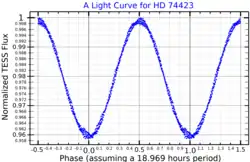HD 74423
HD 74423 is a heartbeat binary star and one component pulsates on only one hemisphere. This is caused by tidal interaction with its partner.[7] The star is located in the Volans constellation.
| Observation data Epoch J2000.0 Equinox J2000.0 (ICRS) | |
|---|---|
| Constellation | Volans[2] |
| Right ascension | 08h 40m 17.985s[3] |
| Declination | −64° 50′ 16.84″[3] |
| Apparent magnitude (V) | 8.58–8.66[4] |
| Characteristics | |
| Spectral type | A7VkA0mA0 λ Boo[5] |
| Apparent magnitude (B) | 8.81±0.02[6] |
| Apparent magnitude (J) | 8.065±0.020[6] |
| Apparent magnitude (H) | 8.021±0.067[6] |
| Apparent magnitude (K) | 7.944±0.040[6] |
| Variable type | α2 CVn[4] or Ellipsoidal and δ Sct[7] |
| Astrometry | |
| Proper motion (μ) | RA: −9.719[3] mas/yr Dec.: 11.732[3] mas/yr |
| Parallax (π) | 2.1018 ± 0.0150 mas[3] |
| Distance | 1,550 ± 10 ly (476 ± 3 pc) |
| Details | |
| primary | |
| Mass | 2.1[8] M☉ |
| Radius | 3.3[8] R☉ |
| Surface gravity (log g) | 3.6[5] cgs |
| Temperature | 7,900[8] K |
| Metallicity [Fe/H] | −1.0[5] dex |
| secondary | |
| Mass | 2.0[8] M☉ |
| Radius | 3.2[8] R☉ |
| Surface gravity (log g) | 3.6[5] cgs |
| Temperature | 7,600[8] K |
| Metallicity [Fe/H] | −1.0[5] dex |
| Age | 800[7] Myr |
| Other designations | |
| Database references | |
| SIMBAD | data |
HD 74423 is slightly variable in brightness. It fluctuates between magnitudes 8.58 and 8.66 every 19 hours.[4] The exact variability type is unclear. It was initially found in a search for α2 Canum Venaticorum variables and assumed to be one, but has since been considered to be a δ Scuti variable.[7] The spectrum shows unusually strong absorption lines of some iron peak elements, a characteristic of λ Boötis stars. Both components are thought to show the chemical peculiarity.[7]
References
- "MAST: Barbara A. Mikulski Archive for Space Telescopes". Space Telescope Science Institute. Retrieved 8 December 2021.
- Staff (2 August 2008). "Finding the constellation which contains given sky coordinates". DJM.cc. Retrieved 31 July 2020.
- Brown, A. G. A.; et al. (Gaia collaboration) (2021). "Gaia Early Data Release 3: Summary of the contents and survey properties". Astronomy & Astrophysics. 649: A1. arXiv:2012.01533. Bibcode:2021A&A...649A...1G. doi:10.1051/0004-6361/202039657. S2CID 227254300. (Erratum: doi:10.1051/0004-6361/202039657e). Gaia EDR3 record for this source at VizieR.
- Bernhard, K.; Hümmerich, S.; Otero, S.; Paunzen, E. (2015). "A search for photometric variability in magnetic chemically peculiar stars using ASAS-3 data". Astronomy and Astrophysics. 581: A138. arXiv:1507.01112. Bibcode:2015A&A...581A.138B. doi:10.1051/0004-6361/201526424. S2CID 54062866.
- Gray, R. O.; Riggs, Q. S.; Koen, C.; Murphy, S. J.; Newsome, I. M.; Corbally, C. J.; Cheng, K. -P.; Neff, J. E. (2017). "The Discovery of λ Bootis Stars: The Southern Survey I". The Astronomical Journal. 154 (1): 31. Bibcode:2017AJ....154...31G. doi:10.3847/1538-3881/aa6d5e.
- "HD 74423 -- Star". SIMBAD. Centre de Données astronomiques de Strasbourg. Retrieved 31 July 2020.
- Handler, G.; Kurtz, D. W.; Rappaport, S. A.; Saio, H.; Fuller, J.; Jones, D.; Guo, Z.; Chowdhury, S.; Sowicka, P.; Aliçavuş, F. Kahraman; Streamer, M. (9 March 2020). "Tidally trapped pulsations in a close binary star system discovered by TESS". Nature Astronomy. 4 (7): 684–689. arXiv:2003.04071. Bibcode:2020NatAs...4..684H. doi:10.1038/s41550-020-1035-1. ISSN 2397-3366. S2CID 212634328.
- Fuller, J.; Kurtz, D. W.; Handler, G.; Rappaport, S. (2020). "Tidally trapped pulsations in binary stars". Monthly Notices of the Royal Astronomical Society. 498 (4): 5730. arXiv:2008.02836. Bibcode:2020MNRAS.498.5730F. doi:10.1093/mnras/staa2376.
This article is issued from Wikipedia. The text is licensed under Creative Commons - Attribution - Sharealike. Additional terms may apply for the media files.
